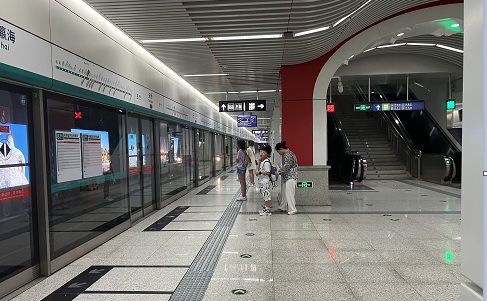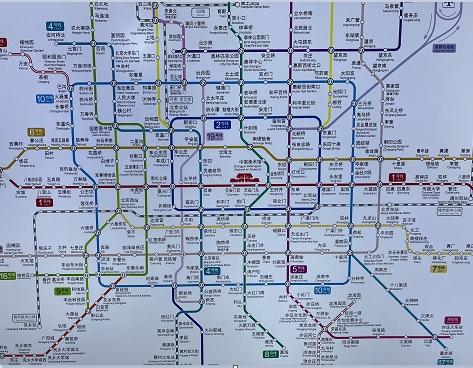Posted On: Monday - September 11th 2023 8:21PM MST
In Topics: China Peak Stupidity Roadshow
(Continued from **Planes**, **Planes-II**, and **Trains** of our Dispatches from The Middle Kingdom: Planes, Trains, and Automobiles series.)

This was a slow time. The stations could get pretty packed.
This Trains-II post is about the Chinese subway systems. I've ridden the subways in 4 Chinese cities now, but the pictures and map shown here are from Peking, so I'll give information on this impressive infrastructure (with a little bit about the one in Shanghai). It's a pretty impressive deal. Things are clean, people are polite (with that one exceptionalism), and things work.
The Chinese are late to this game. The London Underground - not the band, but The Tube, started up in 1863. That's a stretch though, as the barely-underground lines used wooden carriages pulled by coal-burning steam engines. (Talk about your carbon footprint! I imagine there were more than footprints, probably carbon arms, legs, faces and whole bodies disembarking in Paddington Station.) A serious deep-level line with electric trains opened up in London the same year as the New York City system did, in 1904.
Americans, after less than a century of the industrial revolution and only a couple of centuries of civilization, built this amazing transportation infrastructure 67 years before China, with its 3,500 y/o civilization! That's a stretch in favor of China anyway, as the Peking subway consisted of but one measly line from 1971 through '84, and even then, only 2 lines until 20 years back. (Here is a graphic showing the slow growth and then big expansion.) The Soviet Union helped the Chinese design the first part of it, but then they got the hang of it themselves after Communism was long gone and things could get done properly. It was really almost a century after New York's subway opened that Peking could claim a serious subway, but now, in 2023, it's something else.
It's not the case in all stations, but these lines are set up with glass walls in the stations with doors that open only when the train is there and lines up. Are there many Chinese people who'd push people onto the tracks? Well, no, it's not New York, but then it's still a good safety feature. It's just that Americans didn't think of it first... because the nation in 1904 and a long time afterwards was one with a high-trust population. The riders in China were pretty polite while on board, even when it was really packed. Still, when the doors opened, people would push their way on, before letting those who wanted off, get off. I'm telling you, I don't get this!
It's all shiny and new. One thing Peak Stupidity has written about before is that, once things become really old - take the New York City subway (don't mind the maggots!), please - repair mode becomes costlier than build-from-scratch mode. Also, as commenters discussed under these posts before, that shine could change quickly, especially in a place like China. "The commons" are not taken care of well compared to private property in a low-trust society. However, in their favor, they don't have the MTA full of nepotist-AA hires. China is a country of competent people, though the labor force is quickly getting older, a subject for another post.
Just as with the high speed trains in China, it's not the individual shiny trains that I saw and rode on that I'm impressed with the most. It's the big networks that have been built over just a few decades, not just the one in Peking. Most of the big cities have subways now. Based on yearly ridership*, Peking is the 4th biggest subway system in the world, after Shanghai, Tokyo**, and Canton (Guangzhou). It had 2.29 billion riders - they could be the same people, of course, just fare-payers - even in '20. The routes total to 488 miles.

Here's a clearer map. The one above was one taken at one of the stations.
9 of the top 10 subways based on "system length" (meaning the total length of all the routes, without regard to how many sets of tracks lie within each) are in Chinese cities: Shanghai, Peking, Canton, Shenzhen, Chengdu, Hangzhou, Nanjing, Chongqing, and Wuhan. (Moscow is number 9 in the top 10 based on this metric.)
The New York City system is still #1 in number of stations with 424. The Peking system has 370 stations. However, I'm guessing when it comes to amount of urine accumulated within stations, New York is WAY WAY ahead. We saw no bums in the Peking or Shanghai subway stations, just lots of busy reasonably well-dressed Chinese people.
The question of whether these subways are paying for themselves came up in my mind when I paid the very low ticket prices, a buck to a buck and a half. (They are based on distance, something many systems have now due to the abilities of electronics. This makes it much harder to figure out WTF to do at the ticket machines the first time around, no matter what the language!) As with the HS rail, I don't have enough info to figure out whether this mode of transport is subsidized. I will say that you don't need so many employees with the self-serve electronics, etc. Oh, and the Chinese save on DIEversity departments and the like.
PS: In general the signage is pretty good, with pin yin along with the real Chinese language written for stops. On the trains, there are schematics - straight lines - for the route one is on, with LEDs to show the current stop. On the map above, the reader can see 2 full loops, the inner dark blue one and the outer light blue one. Let me tell you from a previous trip, if you lose your sense of direction going deep down into the station due to turns, then the question of which direction on the loop, CW or CCW, the train one is about to board is going is not an easy one to answer! I got lucky...
* ... using this wiki page. Unfortunately, the numbers are not all for the same year. Interestingly, Shanghai numbers are show for '20, and it's still #1.
** Tokyo, as a CITY, would be well ahead as number 1. However, this page lists subway "systems", of which Tokyo has 2, the Tokyo Subway and the Toei Subway. Together, they had 3.93 Billion riders in '19. (Again, comparing different years around the PanicFest time is prone to problems.)
Comments:
SafeNow
Wednesday - September 13th 2023 2:28AM MST
PS
I was quite surprised and puzzled to read that passengers enter before letting passengers exit. I started to see this with elevators in S. Cal
30 years ago. plaques on the wall in the lobby urged people not to do this.
unfortunately the plaques were written in English; it would’ve been xenophobic to do otherwise.
Mr. M, you might be interested in seeing my recent post on Unz in Anglin, it is post number 37. this is a new China Maritime-military patrol vessel that resembles a cruise ship inside! in my caption I speculated what the purpose of such a vessel might be, but I still don’t really like my own explanation and maybe you can do better. in any case I think you would find the photo interesting. apologies if you have already seen it and just have no idea what the heck they have in mind. I have a new theory ..maybe they want to take party dignitaries on inspection tours of the Chinese military fleet so they can see firsthand what the fleet looks like.
I was quite surprised and puzzled to read that passengers enter before letting passengers exit. I started to see this with elevators in S. Cal
30 years ago. plaques on the wall in the lobby urged people not to do this.
unfortunately the plaques were written in English; it would’ve been xenophobic to do otherwise.
Mr. M, you might be interested in seeing my recent post on Unz in Anglin, it is post number 37. this is a new China Maritime-military patrol vessel that resembles a cruise ship inside! in my caption I speculated what the purpose of such a vessel might be, but I still don’t really like my own explanation and maybe you can do better. in any case I think you would find the photo interesting. apologies if you have already seen it and just have no idea what the heck they have in mind. I have a new theory ..maybe they want to take party dignitaries on inspection tours of the Chinese military fleet so they can see firsthand what the fleet looks like.
Moderator
Tuesday - September 12th 2023 7:08AM MST
PS: M, there's definitely that. I mean subsidized on the whole, as in, there's no way the thing can ever pay for itself. Does it even pay operating expenses discounting the huge amount of money to build it out?
I think that's difficult to calculate, as, even if I could get lots of information one how much this and that cost to build and then operating expenses, who knows how much the maintanence will cost? That's something we discussed a bit before. It depends on how well built the stuff is.
I think that's difficult to calculate, as, even if I could get lots of information one how much this and that cost to build and then operating expenses, who knows how much the maintanence will cost? That's something we discussed a bit before. It depends on how well built the stuff is.
M
Tuesday - September 12th 2023 4:54AM MST
PS
I don't think there's a subway system in the world that isn't subsidized. The stations at the periphery just don't get enough traffic.
Admittedly, charging for distance could change that. It would also depend on the alternatives.
I don't think there's a subway system in the world that isn't subsidized. The stations at the periphery just don't get enough traffic.
Admittedly, charging for distance could change that. It would also depend on the alternatives.
" I started to see this with elevators in S. Cal 30 years ago. plaques on the wall in the lobby urged people not to do this, unfortunately the plaques were written in English; it would’ve been xenophobic to do otherwise." Haha! Once someone translated it, there'd be hell to pay... and money.